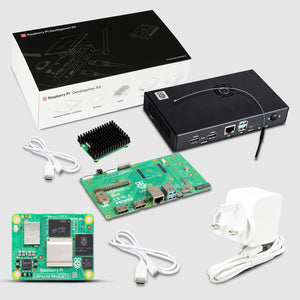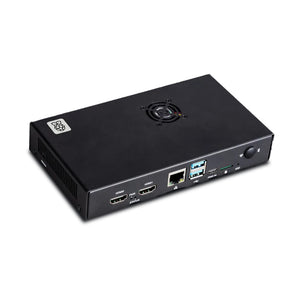Introduction
If you have configured your Raspberry Pi, you probably don’t want tangled cables around you. You can remotely access your RPi’s screen on a local or global network, using VNC (Virtual Network Computing) which is free for non-commercial use. The Raspian operating system comes with the VNC server, by default it is disabled you will need to enable it from the configuration. Through VNC, controlling other Raspberry Pi becomes easily accessible as cables are no longer required and we can completely go wireless with our Pi. The connection can be established between two different operating systems like Windows and Linux with the help of VNC.
In this walkthrough, we will use the VNC viewer from RealVNC.
What is VNC?
VNC (Virtual Network Computing) is a desktop sharing-system to remotely control another computer. By using VNC we can get access to the display of the network.
VNC uses a Remote Frame Buffer Protocol (RFB) for controlling. It sends the keyboard and mouse activities from one computer to another, relaying the graphical-screen updates back in the other direction, over a network. As it works at the framebuffer level it is applicable to all operating systems and applications, including Microsoft Windows, MAC OS, and X Window System.
Video
Set VNC on Raspberry Pi
Enable the VNC on remote Raspberry Pi
- Click on Raspberry Pi icon
- Go to Menu > Preferences > Raspberry Pi Config
- Select Interfaces tab
- Enable VNC with Enabled radio button.

Install VNC Viewer on the local machine
Download the VNC Viewer according to your operating system- https://www.realvnc.com/en/connect/download/viewer/

Install the VNC Viewer.

Enter remote Raspberry Pi’s IP address in the textbox.

Sign in with Raspberry Pi’s username and password.

You can see the screen of remote Raspberry Pi, on your screen. You can set the screen optimization and scale through settings in the cog menu.

VNC is being used in offices, schools, and industries for remotely sharing computers over the network. RFB is not a secure protocol, though passwords are encrypted, cracking is possible if both the encryption key and encoded passwords are sniffed from a network. VNC is widely used for accessing Raspberry Pi by the Raspberry Pi developers.









1 comment
FireSnake
There is also another process that doesnt involve the REALVNC “Licensing” issues, that doesnt require an account made, that doesnt have a limit to how many things you can connect to and so on. REALVNC works, granted, eventually you get tired of the strict limits placed on it from not paying for a full premium account.
This is how to configure REALVNC on the Pi to be compatible with free open-sourced TIGHTVNC Viewer. No account required, No Limit to the devices you can used it with, and its open source linux free software.
-————————————————————————————————
MAGE:
Initial setup you will need to plug in a HDMI monitor and Keyboard and mouse. After a few steps however, those wont be needed any longer. This is how to set up remote network access thru VNC and SSH to your Pi and not need a monitor keyboard or mouse any longer.
Install Raspbian FULL desktop. The desktop would be required for VNC as the minimal install has no graphic desktop, You wont be able to set up VNC without a desktop environment. You can only SSH if your pi boots to only command line, But that is all you would need as the Pi only goes to command line anyway.
Boot up your Raspberry Pi for the first time, Set up the “Country, Language, Timezone and select “US Keyboard” (or whatever country you are from)
When setting your Raspberry Pi password, make it atleast 6 characters. This way you can actually use the SAME PASSWORD for your Pi as you do for your VNC connection. So you have only one password to remember. Keeps it simple.
Connect your WIFI or whatever you will use for a network. Dont worry if it ERRORS and says “Failed to connect network”. Its a bug. Just click OK, then SKIP twice, When you reboot and it will be connected.
AFTER UP TO DESKTOP:
Click the “Start Menu” → Select PREFERENCES → Select RASPBERRY PI CONFIGURATION
Raspberry Pi Configuration:
Change network name to something you can recognize.
Set Resolution to DMT Mode 9 800×600 as the default. (required for headless operation)
Enable SSH
Enable VNC
Enable RemoteGPIO
Click Apply at the bottom and the Raspberry Pi should reboot.
-—————————————————————————
After the Pi Reboots:
VNC should be visible in the toolbar up top next to the clock.
RIGHT Click on it, → Select OPTIONS. On the left side, select EXPERT.
Change the value of ENCRYPTION from “PreferOn” to “AlwaysOff”
On the left side → select SECURITY
change Authentication: from UNIX Password to VNC Password.
Then go to → Users & Permissions
select the button labeled “PASSWORD” on the right upper corner.
Type a password twice and press Enter. (It can be the same as the password for Pi if you like)
Reboot the Pi manually.
Once it comes back up, Your Raspberry Pi will be DONE as far as remote connections go.
-————————————————————————————-
ON YOUR WINDOWS / LINUX Desktop Computer:
You will need a Viewer for your VNC.
TightVNC doesnt Require any accounts to be made and there are no limits to devices like RealVNC does.
I highly recommend TIGHTVNC Viewer. Its Opensource Linux and thus free and works great!
https://www.tightvnc.com/download.php
Install it then look for the link called:
“TightVNC Viewer”
Click on it, it should bring up a small grey box with “CONNECTION REMOTE HOST:”
There you will need to type in the IP address of the Raspberry Pi.
On the Raspberry Pi, open a command line, type in IFCONFIG and press ENTER.
Somewhere in that mess it will show you the IP Address of your Raspberry Pi.
Punch in the IP Address of your Raspberry Pi into the TightVNC Viewer box on your PC and click “CONNECT”
and type in your Password and thats all there is to it!
Now you can UNHOOK your Monitor and Keyboard and mouse from your Raspberry Pi.
Any time you need to access it, you can either use the TightVNC connection to your Raspberry Pi, or you can Secure Shell to to command line.
-——————————————————————————————-
SECURE SHELL INSTRUCTIONS:
Windows users:
Download PuTTy from https://www.putty.org/
While installing it, check the box to make a desktop icon.
Click on the Putty Icon.
Type in your IP Address to putty, dont change any settings at all.
Click CONNECT.
Click YES.
Type in the username Pi
type in your Password.
Thats it! Now you are connected to Raspberry Pi’s Command Line as if you are on the Pi itself.
LINUX SSH Instructions:
Nothing needed. Just type:
SSH pi@192.168.0.2 or whatever your Pi’s IP address is.
Then password. You are done.